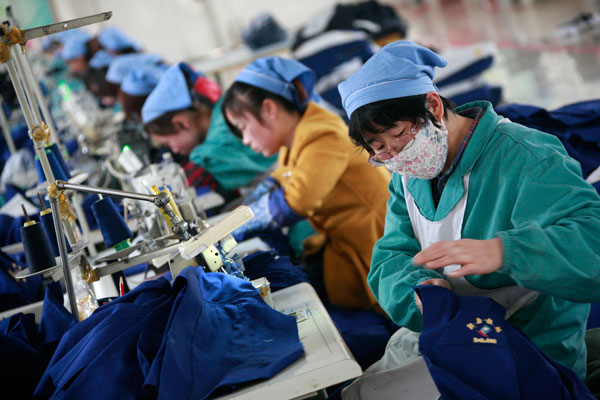Improved production bodes well for overall economy, ysts sayIndustrial activity maintained a moderate recovery in March, with economic indicators reflectingpositive growth.
"The economic environment in Europe seems to have improved, but it has not brought us thesharp increase in orders we had expected for the first quarter," said Zhang Wenhua, owner of acompany in Nanjing, Jiangsu province, that exports machinery to Europe.
 |
A bustling textile factory in Huaibei, Anhui province, reflects the growing momentum of China'anufacturing sector. Xie Zhengyi / For China Daily |
"We just hope there will be more growth in the next three months," Zhang said.
The purchasing managers index, a measure of economic expansion and contraction, reached50.9 in March, slightly above the equilibrium mark of 50.
The index rose to an 11-month high after hitting 50.4 in January and 50.1 in February. It hasremained above 50 for six consecutive months.
The National Bureau of Statistics and the China Federation of Logistics and Purchasingreported on Monday that PMI subindexes for manufacturing output rose to 52.7, overall neworders to 52.3, and export orders to 50.9, the highest since May.
The PMI for all enterprises jumped to 49.3 from 46 in February, reaching a 12-month high,though still in contraction. The PMI for large companies was 51.4, up from 51.3 in February,and that for medium-sized companies was 50.3, up from 48.8 in February.
The slow recovery surprised some ysts, who expected the manufacturing PMI to rise tosomewhere around 52 in March as many factories resumed full production after pausing forChinese New Year in February.
Lu Zhengwei, chief economist of Industrial Bank, said trends will continue toward moderaterecovery. China needs to maintain steady macroeconomic policies, "neither too loose nor tootight", Lu said.
The subindex of raw material purchasing prices dropped to 50.6 in March from 55.5 inFebruary, and the raw material inventory also shrank by 2 points to 47.5.
Liu Ligang, chief economist in China with ANZ Banking Group, said Chinese factories'willingness to increase inventories of raw materials was still weak, which is also expected to adddownside pressure to global commodity prices.
Liu is worried about the economy's growth momentum.
"Compared with the extent of the after-holiday rebound in past years, the recovery in Marchwas noticeably weaker, resulting in an average PMI of 50.5 in the first three months, the sameas the average in the fourth quarter of 2012," he said.
HC Holdings Plc also released a separate manufacturing PMI reading based on its ownsurvey, which posted 51.6 in March, up from 50.4 in February and 52.3 in January.
"China's recovery continues, and it is mainly driven by the gradually improving domestic marketdemand," said Qu Hongbin, chief China economist at HC.
"The decline in input prices suggests a modest pace of demand recovery and moderatinginflationary pressures. This, plus the lingering external headwinds, implies that Beijingpolicymakers should keep a relatively accommodative policy stance in place," he said.
Lian Ping, chief economist with Bank of Communications, predicted that industrial output mayrebound slightly in March to 10.1 percent year-on-year from 9.9 percent during January andFebruary.
"In the first quarter, industrial production may be described as sluggish, as demand was weakin both the domestic and overseas markets. Also, investment in the manufacturing sectorremained far from strong," Lian said.
In the coming few months, investment in infrastructure and properties is likely to accelerate,responding to the government's urbanization boost. With the steady pace of recovery in the USand Europe, this may also help China's overall economy improve, according to Lian.
The economist forecast that China's GDP may grow by 8.1 percent year-on-year in the firstquarter, up from 7.9 percent in the last quarter of 2012.